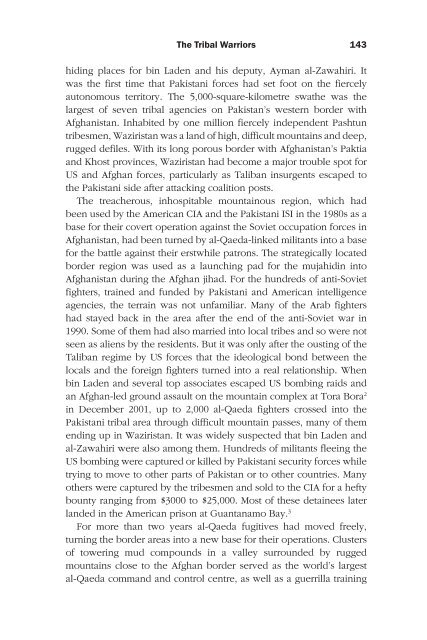Frontline Pakistan : The Struggle With Militant Islam - Arz-e-Pak
Frontline Pakistan : The Struggle With Militant Islam - Arz-e-Pak
Frontline Pakistan : The Struggle With Militant Islam - Arz-e-Pak
Create successful ePaper yourself
Turn your PDF publications into a flip-book with our unique Google optimized e-Paper software.
<strong>The</strong> Tribal Warriors<br />
hiding places for bin Laden and his deputy, Ayman al-Zawahiri. It<br />
was the first time that <strong><strong>Pak</strong>istan</strong>i forces had set foot on the fiercely<br />
autonomous territory. <strong>The</strong> 5,000-square-kilometre swathe was the<br />
largest of seven tribal agencies on <strong><strong>Pak</strong>istan</strong>’s western border with<br />
Afghanistan. Inhabited by one million fiercely independent Pashtun<br />
tribesmen, Waziristan was a land of high, difficult mountains and deep,<br />
rugged defiles. <strong>With</strong> its long porous border with Afghanistan’s <strong>Pak</strong>tia<br />
and Khost provinces, Waziristan had become a major trouble spot for<br />
US and Afghan forces, particularly as Taliban insurgents escaped to<br />
the <strong><strong>Pak</strong>istan</strong>i side after attacking coalition posts.<br />
<strong>The</strong> treacherous, inhospitable mountainous region, which had<br />
been used by the American CIA and the <strong><strong>Pak</strong>istan</strong>i ISI in the 1980s as a<br />
base for their covert operation against the Soviet occupation forces in<br />
Afghanistan, had been turned by al-Qaeda-linked militants into a base<br />
for the battle against their erstwhile patrons. <strong>The</strong> strategically located<br />
border region was used as a launching pad for the mujahidin into<br />
Afghanistan during the Afghan jihad. For the hundreds of anti-Soviet<br />
fighters, trained and funded by <strong><strong>Pak</strong>istan</strong>i and American intelligence<br />
agencies, the terrain was not unfamiliar. Many of the Arab fighters<br />
had stayed back in the area after the end of the anti-Soviet war in<br />
1990. Some of them had also married into local tribes and so were not<br />
seen as aliens by the residents. But it was only after the ousting of the<br />
Taliban regime by US forces that the ideological bond between the<br />
locals and the foreign fighters turned into a real relationship. When<br />
bin Laden and several top associates escaped US bombing raids and<br />
an Afghan-led ground assault on the mountain complex at Tora Bora 2<br />
in December 2001, up to 2,000 al-Qaeda fighters crossed into the<br />
<strong><strong>Pak</strong>istan</strong>i tribal area through difficult mountain passes, many of them<br />
ending up in Waziristan. It was widely suspected that bin Laden and<br />
al-Zawahiri were also among them. Hundreds of militants fleeing the<br />
US bombing were captured or killed by <strong><strong>Pak</strong>istan</strong>i security forces while<br />
trying to move to other parts of <strong><strong>Pak</strong>istan</strong> or to other countries. Many<br />
others were captured by the tribesmen and sold to the CIA for a hefty<br />
bounty ranging from $3000 to $25,000. Most of these detainees later<br />
landed in the American prison at Guantanamo Bay. 3<br />
For more than two years al-Qaeda fugitives had moved freely,<br />
turning the border areas into a new base for their operations. Clusters<br />
of towering mud compounds in a valley surrounded by rugged<br />
mountains close to the Afghan border served as the world’s largest<br />
al-Qaeda command and control centre, as well as a guerrilla training<br />
1













